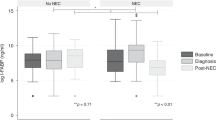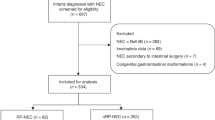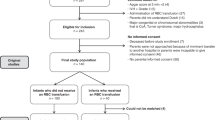Abstract
ABSTRACT: The intestinal contents of 17 neonates with necrotizing enterocolitis were analyzed for pH, carbohydrate, protein, and bacteria. The intraluminal pH was <5.0 (16/17). Sufficient carbohydrate and bacteria capable of fermenting the carbohydrate to organic acids were found. The intraluminal protein content was >5 g/dl. The variables of acid and protein were then examined in a rabbit intestinal loop model. The hemorrhagic response in individual loops was measured using Cr51 tagged red blood cells such that the microliters of blood per centimeter intestine could be determined. Loops with organic acid and protein had significantly (p < 0.01) more intramural blood than control loops. Organic acid (possibly generated by bacterial mixed acid fermentation of carbohydrate) in the presence of protein promotes intramural hemorrhage similar to that seen in neonates with necrotizing enterocolitis.
Similar content being viewed by others
Article PDF
Author information
Authors and Affiliations
Rights and permissions
About this article
Cite this article
Clark, D., Thompson, J., Weiner, L. et al. Necrotizing Enterocolitis: Intraluminal Biochemistry in Human Neonates and a Rabbit Model. Pediatr Res 19, 919–921 (1985). https://doi.org/10.1203/00006450-198509000-00010
Received:
Accepted:
Issue Date:
DOI: https://doi.org/10.1203/00006450-198509000-00010
This article is cited by
-
Necrotising enterocolitis and localised intestinal perforation: different diseases or ends of a spectrum of pathology
Pediatric Surgery International (2006)
-
Elevation of intestinal substance P by acute acetic acid in rabbits: Modification by infant formulas
Inflammopharmacology (1992)
-
Hemodynamic and permeability characteristics of acute experimental necrotizing enterocolitis
Digestive Diseases and Sciences (1990)
-
Neonatal necrotizing enterocolitis
Digestive Diseases and Sciences (1988)



